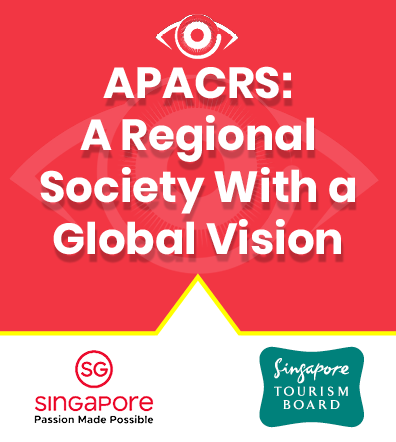Eyeworld Weekly Update |
Volume 20, Number 19 |
22 May 2015 |
- NDA for OTX-DP for postop pain to be submitted
- Advanced-stage glaucoma drug granted orphan status in EU
- EBI-005 for DES failed to meet co-primary endpoints
- iSONEP fails to meet primary, secondary endpoints in AMD study
- Survey: 'Readers' make people look 10 years older
NDA for OTX-DP for postop pain to be submitted
Dextenza (formerly known as OTX-DP) will be submitted to U.S. regulators for the treatment of post-surgical ocular pain, developer Ocular Therapeutix (Bedford, Mass.) said. The company plans to start an additional phase 3 clinical trial of Dextenza with modifications from its original phase 3 postop ocular inflammation and pain study, randomizing patients in a 1:1 ratio into treatment and placebo groups and providing more protocol specificity regarding the administration of rescue medications. Once complete, the New Drug Application will be revised to broaden the indication to include postop inflammation.
Dextenza is also under evaluation for the treatment of allergic conjunctivitis and inflammatory dry eye disease, and for the treatment of allergic conjunctivitis, for which two Phase 3 trials are to be conducted beginning in the middle of 2015.
Advanced-stage glaucoma drug granted orphan status in EU
ISTH0036, a locked nucleic acid-modified antisense oligonucleotide for the prevention of scarring post filtration surgery in glaucoma, has been granted orphan drug status in the European Union, developer Isarna (Munich, Germany) said in a press release.
ISTH0036 is currently "the sole compound in clinical development worldwide that directly targets TGF-β2, which is seen as a core driver of glaucoma pathophysiology and the scarring process post-glaucoma filtering surgery," the company said.
EBI-005 for DES failed to meet co-primary endpoints
EBI-005, for the treatment of moderate to severe dry eye disease, failed to meet either of its 2 co-primary endpoints in a phase 3 study, developer Eleven Biotherapeutics (Cambridge, Mass.) said in a news release. The co-primary endpoints of the Phase 3 study were the total corneal fluorescein staining score and the patient-reported measurement related to ocular pain and discomfort based on the ocular surface disease index, comparing the mean change from baseline at week 12 for treatment with EBI-005 to treatment with vehicle control.
As a result, the company has halted further development on EBI-005 in dry eye, and instead will concentrate on moving the compound into a pivotal study for allergic conjunctivitis in the second half of the year.
iSONEP fails to meet primary, secondary endpoints in AMD study
A phase 2 study of iSONEP did not meet its primary or key secondary endpoints in patients who had not responded adequately to anti-vascular endothelial growth factor in the treatment of wet age-related macular degeneration (AMD), developer Lpath (San Diego) said in a news release. Wet AMD patients did not show any statistically significant improvement in visual acuity when treated with iSONEP as an adjunctive or monotherapy, Lpath said, although the drug was well-tolerated across all dosing levels.
Survey: 'Readers' make people look 10 years older
According to a new survey conducted by Jacksonville University (Fla.), 1 in 4 adults say reading glasses can make someone look 10 years older. The survey, conducted in collaboration with Alcon (Ft. Worth, Texas), was designed to evaluate the effect that readers have on perceived age, and the need for education about presbyopia. The Age Perception Impact Survey, conducted online, examined the perceptions and attitudes of aging among the U.S. population between the ages of 38-54, also known as the Generation X population. It surveyed 1,067 adults who live in the continental United States. In addition, Dr. Hausenblas, who evaluated the online survey data, conducted 50 in-depth live interviews, which included sharing pictures of individuals with and without readers and asking interviewees to guess their age and personal attributes.
Key findings from the survey showed that although the majority of adults value looking younger (68%), almost half do not feel younger than their current age (49%). To help feel younger, many adults are dyeing their hair (42%) and wearing youthful outfits (37%). Additionally, they see facelifts and teeth whitening as some of the most expensive ways to look younger.
According to the survey, nearly half of Americans (49%) would consider avoiding readers if they knew it made them look older. Of emerging presbyopes between the ages of 38-54, up to 40% may mistake their presbyopia for eye fatigue, but more than one-third said they would visit an eye care practitioner (ECP) if they knew the ECP could help. Of those presbyopes who do not visit an ECP about their symptoms, 20% say they do not know there are remedies for presbyopia.
RESEARCH BRIEFS
- Besifloxacin appeared more effective in reducing bacterial counts on eyelids of patients undergoing cataract surgery, with significant reductions as early as 1 hour postdose, compared with moxifloxacin, according to Frank A. Bucci, Jr., MD, and colleagues. They prospectively randomized 59 patients (n=28 besifloxacin, n=31 moxifloxacin) to receive the drugs QID for 3 days before cataract surgery in the operated eye, and 1 hour before surgery in the non-operated eye to investigate the ocular bacterial flora and antibacterial effects of the two drugs. The majority (73%) of conjunctival samples were culture negative at baseline. The most frequent isolates were coagulase-negative staphylococci (CoNS, 89%), specifically Staphylococcus epidermidis (72%). Both fluoroquinolones reduced the bacterial flora load, but only besifloxacin reduced the value an hour after instillation with a single drop (P=0.039). The minimum inhibitory concentration (MIC90) of besifloxacin against methicillin-resistant S. epidermidis was eightfold lower than that of moxifloxacin. The study is published in Clinical Ophthalmology.
- Although corneal thinning was observed in keratoconus patients, the anterior scleral stroma thickness in these patients seemed to be similar to that in healthy control eyes, according to a study designed to determine whether the scleral stroma is affected as much as the corneal stroma in keratoconus. In this comparative, case-controlled study, B. Schlatter and colleagues analyzed 101 eyes (51 with keratoconus, 50 control eyes). The mean central corneal thickness in the keratoconus group was statistically significantly lower than in the control group (447.8 μm ± 57.8 vs. 550.5 ± 35.5 μm) (P < .0001). No significant difference in the mean anterior scleral thickness was found between the keratoconus group and the control group (479.1 ± 43.7 μm versus 474.2 ± 43.0 μm) (P=0.57). The study is published in Journal of Cataract & Refractive Surgery.
- The MEL 90 excimer laser (Carl Zeiss Meditec, Jena, Germany) using the Triple-A ablation profile with a 500-Hz pulse rate was found to achieve a small but real increase in contrast sensitivity and high efficacy for myopia up to -10.00 D and cylinder up to 5.00 D without the need for a nomogram adjustment, according to Daniel Z. Reinstein, MD, and colleagues. They retrospectively analyzed the first 286 myopic LASIK procedures (147 patients) by two experienced surgeons in which the VisuMax femtosecond laser and MEL 90 excimer laser were used following a standardized surgical technique. Flap thickness was between 80 and 110 µm and optical zone was between 6 and 7 mm, and follow-up was 3 months. Preoperatively, mean spherical equivalent refraction (SEQ) was -3.83 ± 1.83 D (range: -0.13 to -10.38 D) and mean cylinder was -0.94 ± 0.86 D. Postoperative SEQ was ±0.50 D in 88% and ±1.00 D in 100% of eyes. Preoperative corrected distance visual acuity (CDVA) was 20/20 or better in 97% of eyes. Postoperative uncorrected distance visual acuity was 20/20 or better in 92% and 20/25 or better in 99% of eyes. One line of CDVA was lost in 6% of eyes and no eyes lost two or more lines. The study is published in Journal of Refractive Surgery.
NEW PRODUCT BRIEFS
- Bausch + Lomb (Bridgewater, N.J.) has launched a number of enhancements to its Trulign Toric IOL calculator to now allow surgeons to immediately calculate the steep axis from the data entered in the flat axis section, perform concurrent bilateral calculations, and view the axis of placement located in the center of eye and the residual astigmatism clearly located in the eye diagram.
- Bausch + Lomb Surgical Instruments introduced the newly designed E2516 (CCW) and E2517 (CW) Erickson-Lee Pigtail Lacrimal Probes in the United States. These new probes are designed with a counter-clockwise or clockwise orientation to accommodate right and left tear duct probing and irrigation and feature cannulated probes for easier insertion, the company said.
 Licensed Publications |
Licensed through ASCRS American Society of Cataract and Refractive Surgery, 4000 Legato Road, Suite 700, Fairfax, VA 22033-4003, USA.
All rights reserved. The ideas and opinions expressed in EyeWorld Asia-Pacific Weekly News do not necessarily reflect those of the ASCRS�ASOA or APACRS. Mention of products or services does not constitute an endorsement by the ASCRS�ASOA or APACRS. Copyright 2008, EyeWorld News Service, a division of ASCRS Media. |



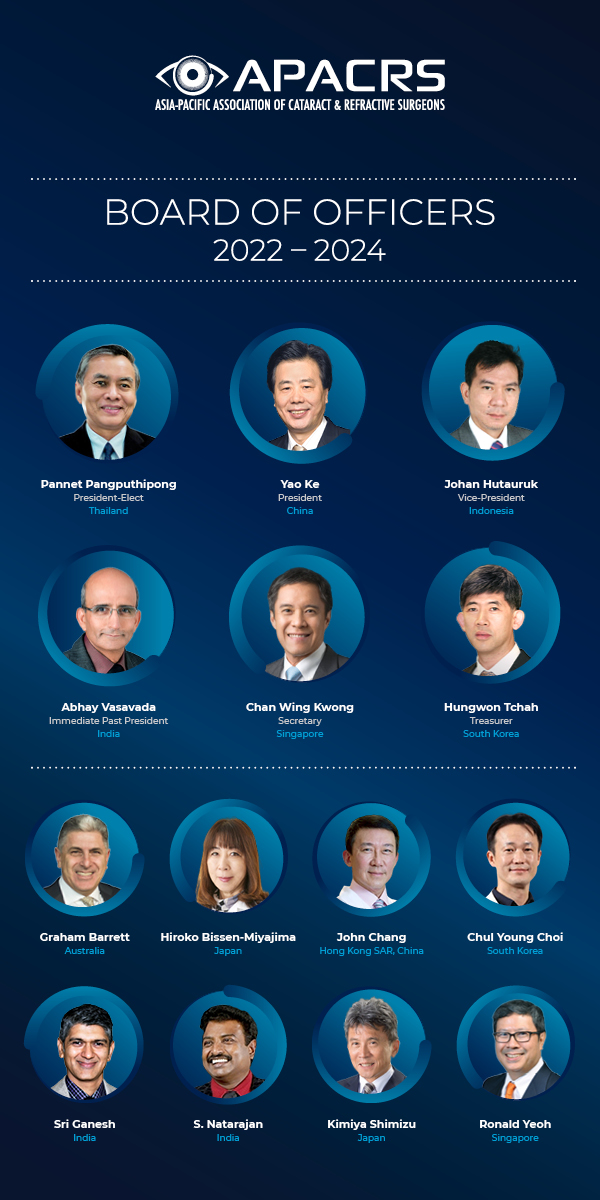
 EyeSustain Update
EyeSustain Update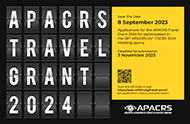 2024 APACRS TRAVEL GRANT
2024 APACRS TRAVEL GRANT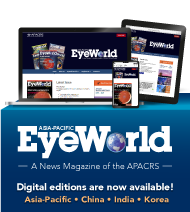 Digital EyeWorld
Digital EyeWorld VOL. 39 (2023), ISSUE 3
VOL. 39 (2023), ISSUE 3  Membership Information
Membership Information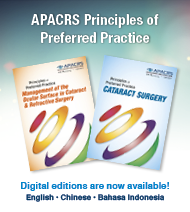 APACRS Principles of Preferred Practice
APACRS Principles of Preferred Practice